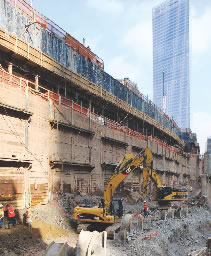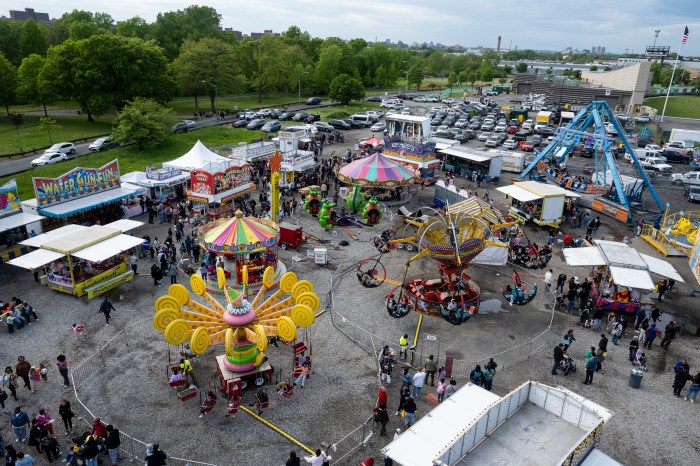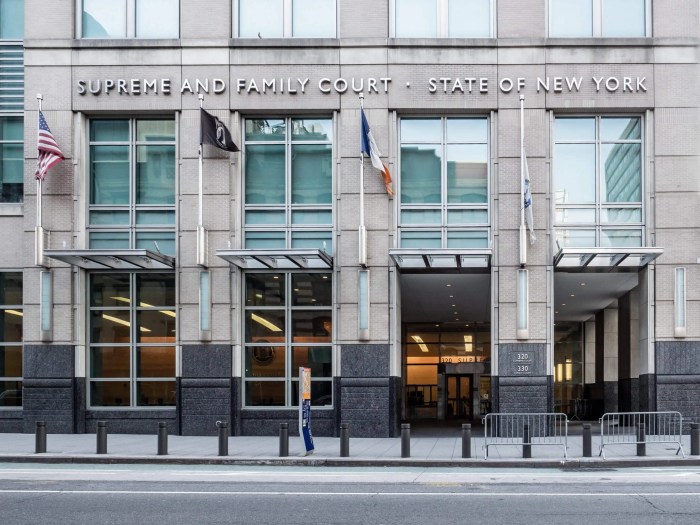By Julie Shapiro
Janno Lieber, head of World Trade Center construction for Silverstein Properties, has no tolerance for unnecessary delays.
When a projector wasn’t ready for his testimony at a City Council hearing Friday, Lieber decided to start without it.
“I don’t want to kill time,” he said. “It’s the one thing I…I refuse to waste time.”
That characteristic surfaced again and again as Lieber spoke about both the progress and the uncertainty at the World Trade Center site, where Silverstein is charged with building Towers 2, 3 and 4. Lieber responded to City Councilmember Alan Gerson’s questions, painting a picture of a company quivering with anticipation to plow forward.
“Our organization is not interested in dragging this out,” Lieber said. “We want to keep the construction we have underway going. We’ve got both general contractors and subcontractors hired, on board, ready to go.”
But all the energy in the world can’t change the fact that Silverstein’s towers will not rise in a vacuum. They are dependent on many of the projects the Port Authority is building: the PATH hub, the Vehicle Security Center and a new Greenwich St., along with utilities and other infrastructure. The memorial, which the Port is also building, has a less direct effect on the office construction.
The Port announced a revised timeline for those projects in October, with dates years later than had previously been publicized. Lieber said he is still trying to figure out how those delays will impact Silverstein’s towers. That is a particularly difficult task because the Port has not released the data and risk assessments that produced the new dates, Lieber said.
“We are all wondering and getting kind of frustrated with the progress, and rightfully so,” Lieber said.
But Lieber pointed out that in the meantime, work at Tower 4, in the southeast corner of the site, is going forward at full speed, with the below-street-level appearance changing week by week. Tower 4 will be complete by the second or third quarter of 2012, Lieber said.
That is, unless the construction hits a wall — literally. The Port Authority was supposed to excavate the Tower 4 site, but rather than clearing it entirely, they put up a 400-foot wall right where the western columns of Tower 4 will go, Lieber said. The wall holds back a mound of land beneath the No. 1 subway box — land the Port was also supposed to excavate, Lieber said.
“They weren’t able to get it done, so they put up the wall, and for whatever reason they elected to put up that wall smack on the foundation,” Lieber said.
The wall hasn’t slowed Tower 4 construction yet, but it could if it stays there.
A Port Authority official said the wall is outside the Tower 4 footprint, and it will stand until the Port excavates beneath the No. 1 subway and braces it with steel.
“The issue is whether the wall is on Silverstein’s property or our property,” said the official, who spoke on the condition of anonymity. “We’re saying it’s on our property.”
The question of the property line could be an expensive one. Over the summer, the Port was paying Silverstein $300,000 a day for missing the June 30 deadline of turning over the sites for Tower 2 and a piece of Tower 4. The Port stopped paying in October, saying the sites were ready. Silverstein contends that the sites are not ready and that the Port still ought to be paying the daily penalty.
Silverstein and the Port could not resolve the dispute on their own, so they entered arbitration this week. A binding judgment will likely come next week, the Port said.
This will not be the last time the Port Authority’s work affects Silverstein’s towers. No matter how quickly Silverstein builds Towers 2, 3 and 4, the space will be impossible to rent if it still sits in the middle of a construction site.
“Companies want to come to a place that feels finished,” Lieber said.
The city and Port have committed to lease 600,000 square feet each in Tower 4, which will fill two-thirds of the building.
Lieber spoke Friday of the many pieces of the site that will need to be in place for the towers to open — and all of them are outside of Silverstein’s direct control. Silverstein will need access to loading docks through the Vehicle Security Center, which will not be done until 2012. The new PATH hub will help attract office tenants, but it’s not scheduled to open until the end of 2013 or the beginning of 2014.
“We’re working with the Port Authority to try to figure out how reliable those new dates are,” Lieber said. “Then we will have a discussion with them about how that impacts our schedule.”
One of the largest question marks in Lieber’s mind is Greenwich St., the front door to Silverstein’s towers. In October, the Port announced a new top-down construction of Greenwich St. that would allow it to open by the end of 2012, but Lieber said he has not seen details of how the top-down method will work. The Port is working out the details of the design, but the sooner they can share it, the better, Lieber said.
“If any adjustments need to be made because of their new top-down [construction], it needs to be addressed very, very quickly,” Lieber said. “So we’re urging them to pick up the pace on that dialogue.”
Greenwich St. is a particularly complicated project because of the layers of infrastructure: mechanical space and parking on the bottom, then the No. 1 subway line, then utilities, then the streetscape itself.
“It is the north-south spine of this project,” Lieber said. “So it is very, very clear that you cannot have a functioning rebuilt World Trade Center if Greenwich St. is not finished and operable.”
Steve Coleman, spokesperson for the Port Authority, did not comment on Lieber’s requests for information sharing. When Chris Ward, Port executive director, outlined a new direction for the W.T.C. rebuilding last summer, transparency and stakeholder cooperation were two of his key points. And while the stakeholders did meet over the summer, communication has apparently grown less frequent since then.
At Silverstein’s towers, construction schedules for Towers 2 and 3 are behind Tower 4, and Lieber could not say Friday whether they would open by 2013 and 2014, as was planned. The dates will depend on work on the rest of the site. Work at Tower 3 was on hold for several months earlier this year while Silverstein negotiated with Merrill Lynch over a possible redesign, but that deal fell through.
During Friday’s hearing, Gerson repeatedly asked Lieber if the financial downturn would prevent Silverstein from raising the money to build his towers. And, repeatedly, Lieber said it would not.
Usually, builders of office towers must secure tenants in order to secure private construction financing. But Silverstein already has the money to build the towers, a combination of Liberty Bonds and insurance funds, Lieber said. That gives Silverstein the flexibility to build even during a poor economy, and find tenants later. Across from the Trade Center site, Silverstein built 7 W.T.C. using the same financing method.
One potential wrinkle is that Liberty Bonds are set to expire at the end of 2009, which would not give Silverstein enough time to sell them. Usually the bonds are sold near the end of the construction process, not the beginning, so it would be hard to find buyers within the next year. The Port Authority is speaking to Congress about extending the 2009 deadline, said Coleman, the Port spokesperson.
The question remains, though, of who Silverstein’s tenants will be. Silverstein is building trading floors, though few financial companies are looking to expand now.
“We’re not building for this market,” Lieber said. “We’re building for another market five years from now. It may be good, it may be not, but it’s a different market.”
All of Silverstein’s towers could be used as conventional office space if the financial sector is still suffering in five years.
Lieber, though, is more optimistic.
“New York is going to come back gangbusters,” he said.
Julie@DowntownExpress.com
















